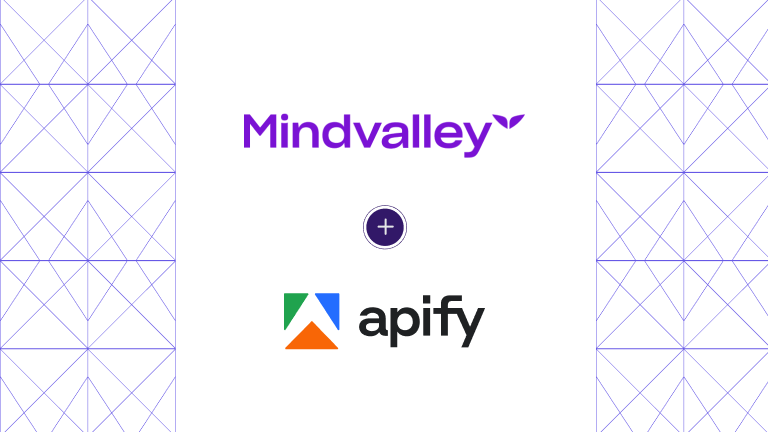Extracting data from Instagram reels can help you identify what’s trending on the social media platform and which creators are making that content. Apify can scrape all the data you need from Instagram reels, without needing to know any code, using Actors. These small programs run entirely in our ecosystem, though you can execute them via API calls, too.
To scrape Instagram reels, we have two Actors you can use:
- Instagram Hashtag Scraper for reels discovery and research, which scrapes caption, author username, likes, comments count, play count, video URL, hashtags, and posting date, among others. Use this scraper to discover what reels are out there for your topic in general, and get an idea of how they are performing.
- Instagram Reel Scraper for targeted reels analysis, which gets you all engagement metrics in one go — likes, comments, shares, video plays, views, and duration — plus hashtags, posting time, caption, audio, and a sample of the latest comments. Use this scraper to zero in on reels' performance of a particular list of creators: either the ones that inspire you or the ones that compete with you.
All this data can then be downloaded into JSON, XML, CSV, or Excel formats, among others, or exported into your existing workflow and used for things such as trend analysis, identifying popular creators, competitor scanning, or hashtag performance tracking.
How to scrape reels by hashtag
First, let’s use Instagram Hashtag Scraper to get reels about topics or trends you find interesting. If you want to scrape reels from specific creators, go to the next section instead.
Step 1: Create an Apify account and open the Actor
To use an Actor on Apify Store, you first need to create a free account. All that’s required is to submit your email, verify it, and you’re ready to go.
Once you have an account, clicking on Try for free on Instagram Hashtag Scraper will take you to Apify Console, or the backend of the Actor.
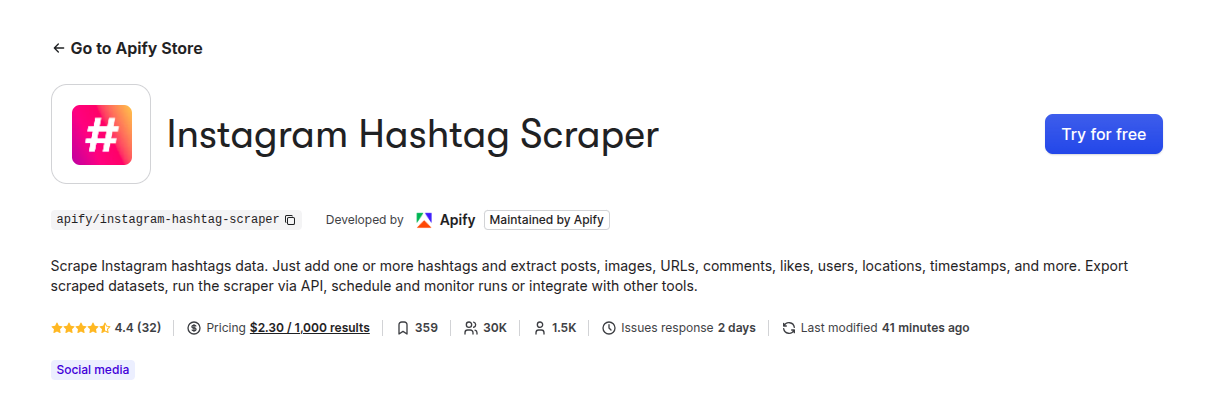
Step 2: Enter your hashtags or keywords
The Console is the command center for an Actor and where you set its input. In the case of Instagram Hashtag Scraper, it’s pretty straightforward: you enter all the hashtags you want to scrape, whether you want to extract reels or posts, and how many results you want. Here’s an example:
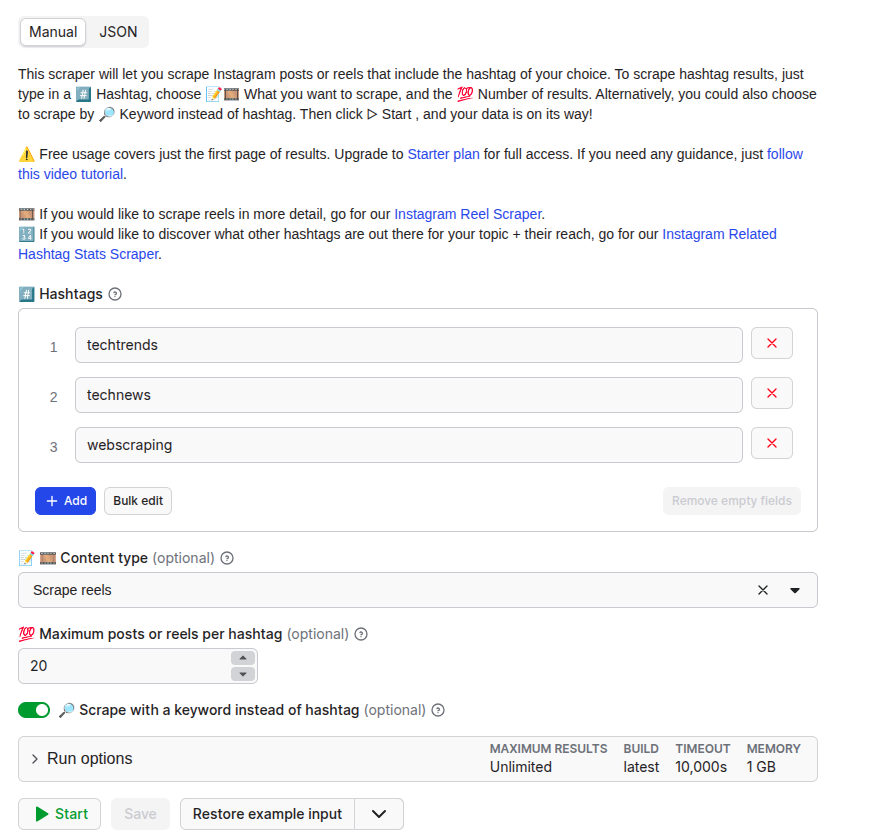
For our purposes, we want reels, so make sure to choose that in 📝 🎞️ Content type dropdown.
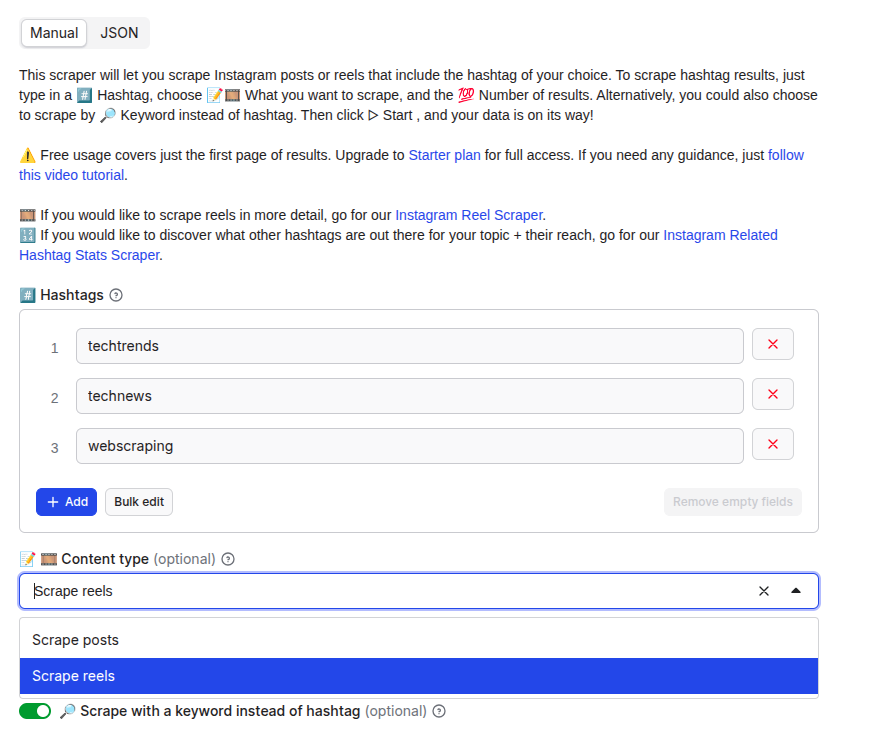
You can determine how many results you want by setting 💯 Maximum posts or reels per hashtag. The default is 20 per hashtag.
You also have the option of scraping by keywords instead of reels by toggling the 🔎 Scrape with a keyword instead of a hashtag option at the bottom of the input field. Instagram shows slightly different results for keyword search and hashtag search. So to have a full picture of what reels are out there for your topic, you can try scraping by both and comparing the results.
Step 3: Run the scraper
Click on Save & Start below the input fields, and the Actor will get to work. Much of the hard work of scraping is done here, but the Actor will bypass any blocks Instagram has put up, as well as scale any large queries.

Step 4: Export your dataset
Once the Actor has finished a run, you’ll see a table containing all the data it scraped. The most interesting fields for you are probably things like the caption, author username, likes, comments count, hashtags, play count, video URL, and posting date~~.~~
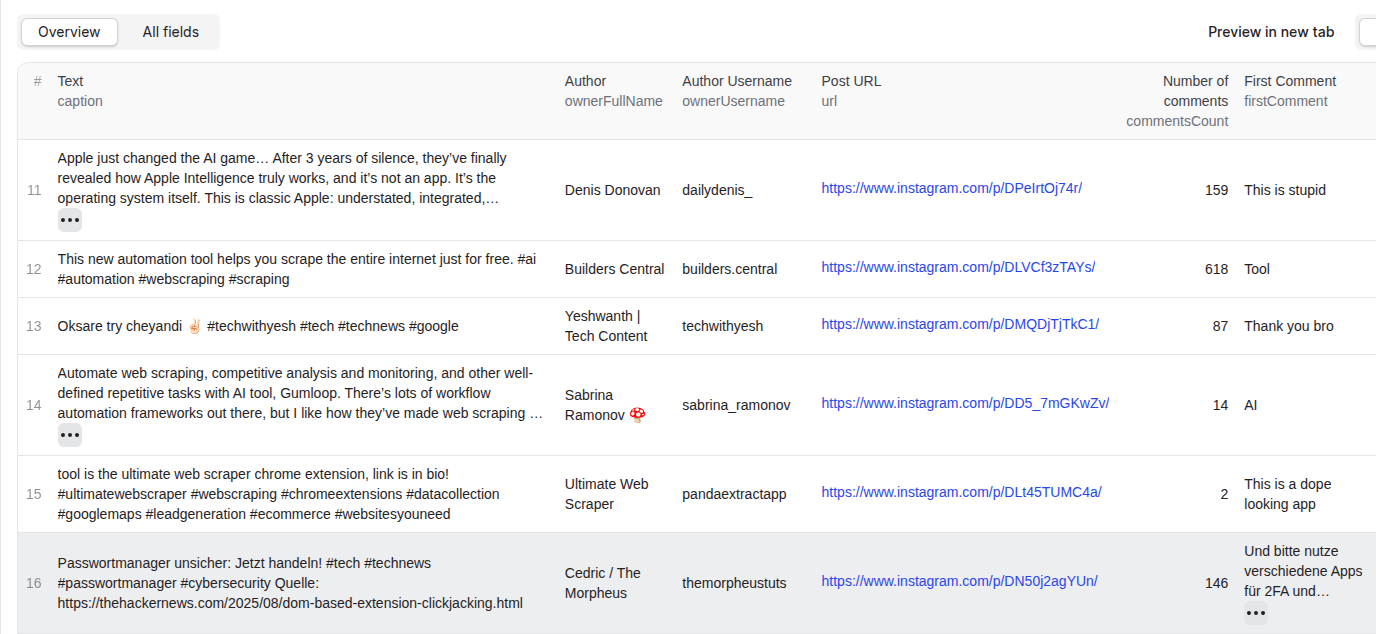
You can also view results in JSON format within the UI, or export them as JSON, CSV, or Excel. To do so, click on the Export button in the top right of the screen. A window will pop up letting you choose the file format and which fields to include or omit.

You can use this data in other tools and workflows for all kinds of purposes, such as analyzing trends, identifying creators in the same space as you, or tracking the performance of certain hashtags.
Step 5: Schedule the Actor
Finally, you can also schedule Instagram Hashtag Scraper to run on a regular schedule, which is a great way to track changes to your data over time. To do so is simple: enter the variables you want in the input screen in the Console, then, in the top right corner, click on Create task. This saves the current configuration as a task - make sure you give it a memorable name.

You’re then brought back to the input screen, but now in the top right of the screen, you can click on the three horizontal dots, and you’ll see an option for Schedule. Click on that.
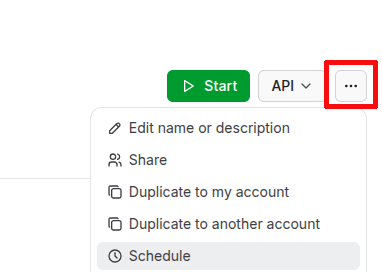
Next, you can set the schedule, whether hourly, daily, or weekly; it’s up to you.
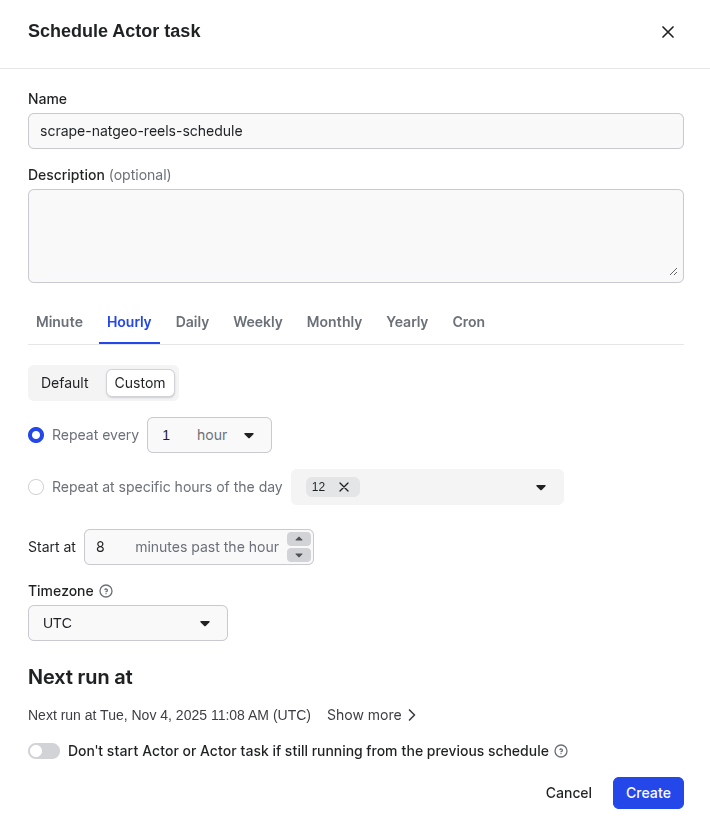
How to scrape reels from specific accounts or URLs
Where Instagram Hashtag Scraper can be used to discover trends, you can use Instagram Reel Scraper to scrape reels from specific creators and see what kind of videos they’re putting out, how they are performing, and what audiences they’re targeting. We have laid out the steps below, but you can also follow along with our video tutorial:
Note that if you’re a more experienced user, you can also use the Instagram reel API to retrieve any data; check out the Actor’s API tab for more information.
Step 1: Open Instagram Reel Scraper
Assuming you’ve already created your free account, navigate to Instagram Reel Scraper either by clicking the link or searching for it in Apify Store. Once there, click on Try for free in the top right of the screen to go to the Actor dashboard, which we call Apify Console.

Step 2: Add usernames, profile URLs, or reel URLs
Instagram Reel Scraper has two input options. You can enter a list of usernames, IDs, or user URLs to monitor specific users, or extract content with the URLs of specific reels. You can enter these one by one, or try adding an entire list at once, using the Bulk edit option.
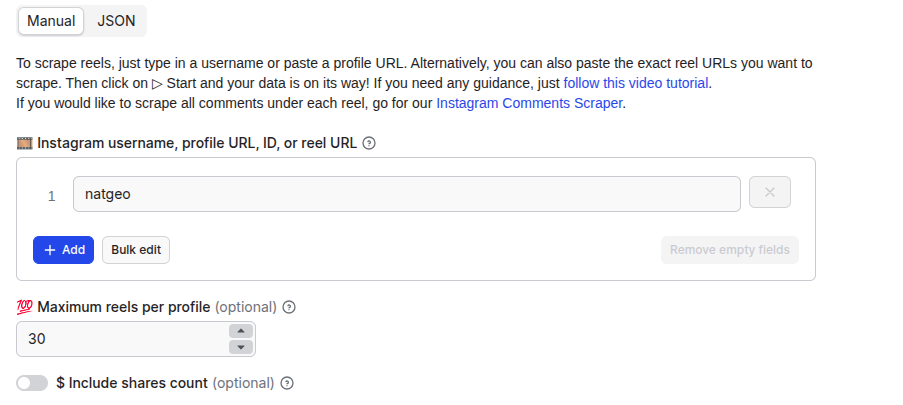
Note that either input is best used for monitoring and analysis, not discovery. For discovery, we recommend going back to Instagram Hashtag Scraper first.
Also, if you’re on a paid plan, you can opt to include the number of times a reel has been shared, which is valuable to see how viral a reel went.
Step 3: Run the scraper
Once you have everything set up, click on Save & Start below the input fields, and the scraper will get to work. The process shouldn’t take more than a minute or two, depending on how much you’re asking the Actor to do.

Step 4: Export your results
Once the scraper is finished, you can see all your results in a table in the UI. This should be familiar to you if you’ve used Instagram Hashtag Scraper, but it has some additional fields, like latest comments and shares count, if you’ve activated it. These should help you more effectively gauge the engagement and performance of reels.
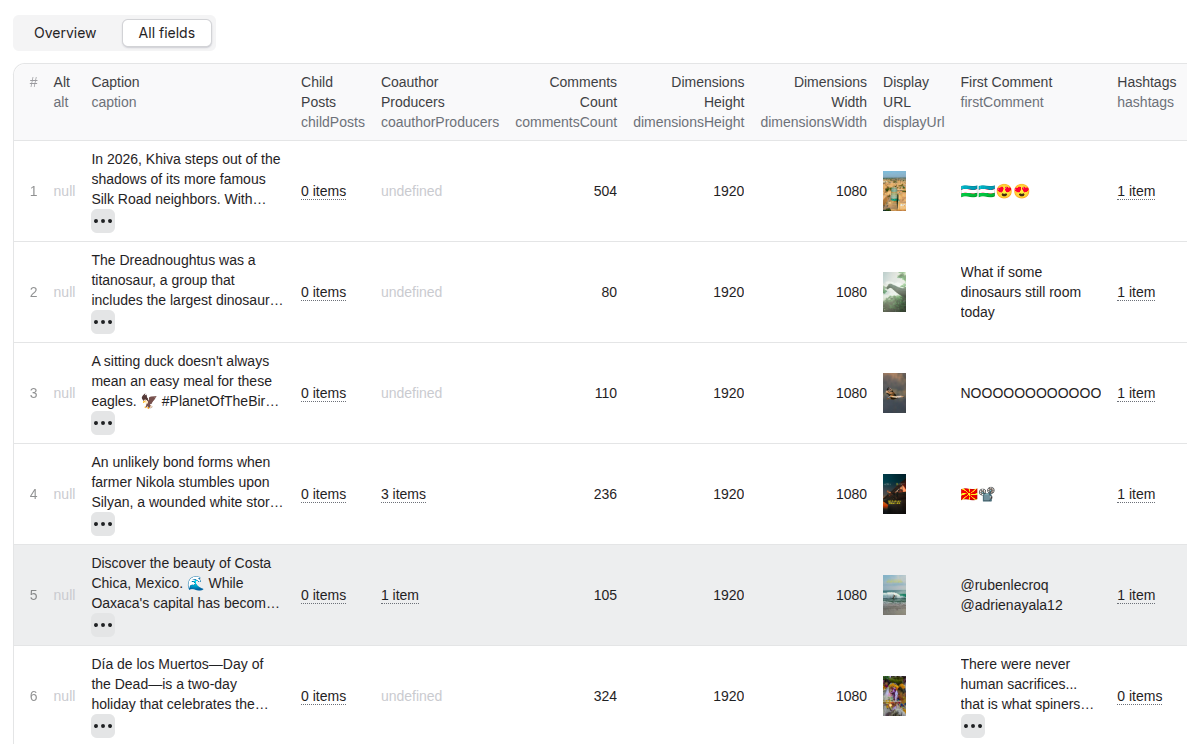
Naturally, you can export the data for use elsewhere. Click on Export in the top right of the screen, and you’ll get a range of options, including downloads in JSON, XML, and Excel formats.
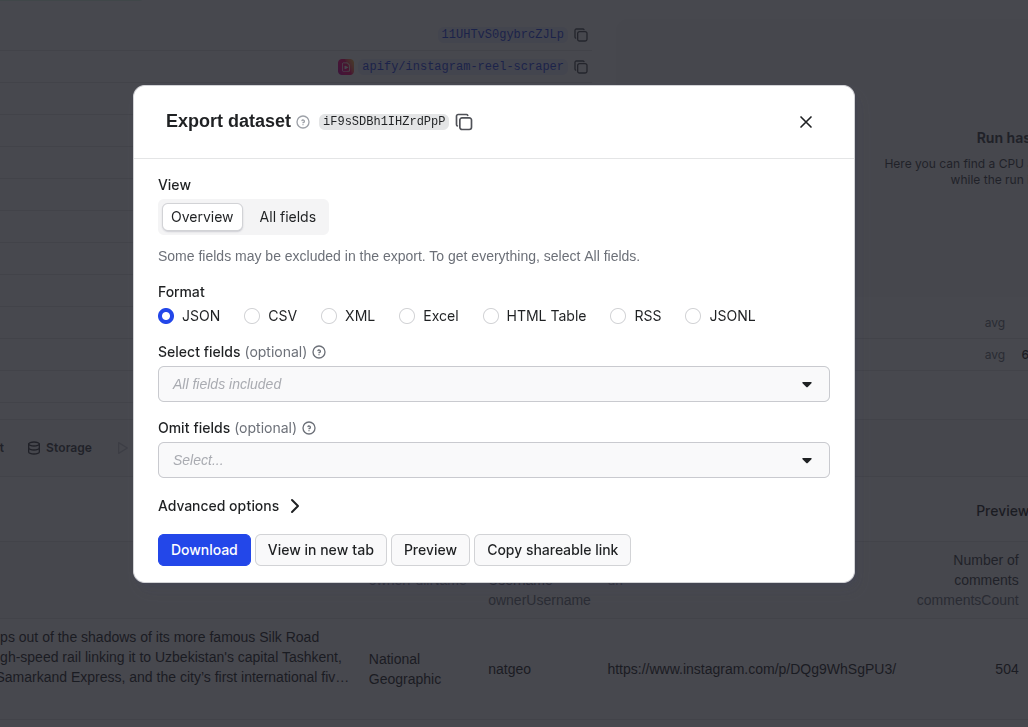
Step 5: Schedule the Actor
To make sure you stay on top of what other creators are doing, you can run Instagram Reel Scraper on a regular schedule, much like we did with Instagram Hashtag Scraper. The steps are the same. Once you’re finished, you can check under Schedules in the Console if everything is set up the way you like.
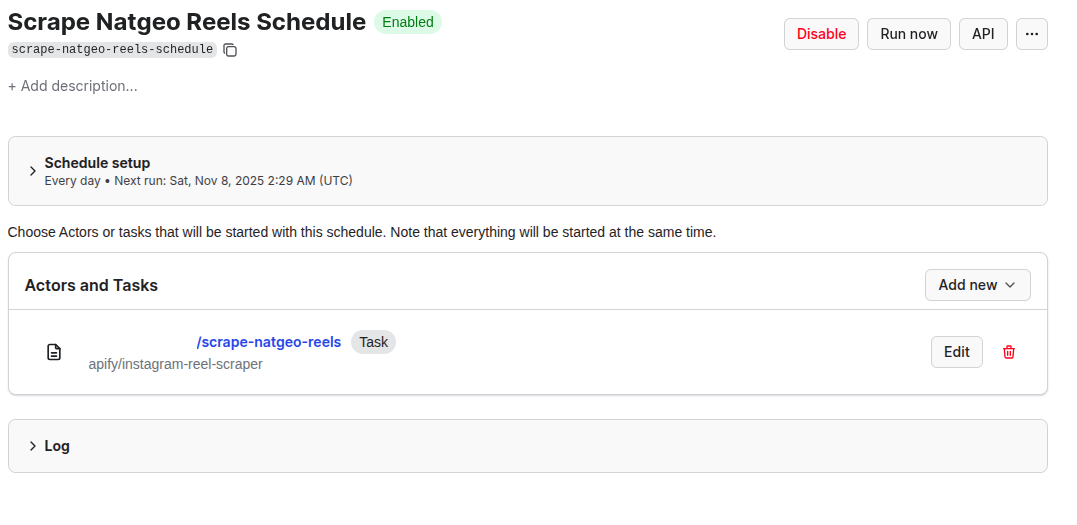
Integrate Instagram reel data with other apps
If you’ve saved an Actor’s configuration as a task, you can also set up integrations with other Actors or even other services, cutting a lot of manual hassle out of your workflows. To get started, go to the Integrations tab of your task and see what’s available.
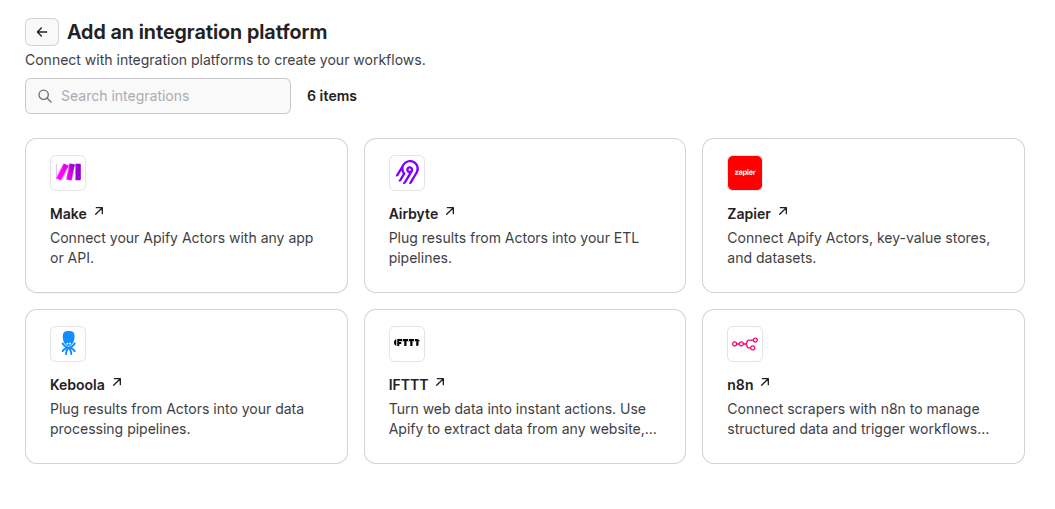
You can integrate most Apify Actors through this menu. We also have plenty of templates with services like Make, n8n, or Zapier. Read our documentation on integrations for more on all this.
Use Instagram Reel Scraper through API
Naturally, both Instagram scrapers can be used through API to then have the reels data fed into any app or workflow. Each Actor has examples on how to trigger it using either JavaScript or Python; here is a Python example for the Instagram reel API:
from apify_client import ApifyClient
client = ApifyClient("<YOUR_API_TOKEN>")
run_input = {
"username": ["natgeo"],
"resultsLimit": 30,
}
run = client.actor("apify/instagram-reel-scraper").call(run_input=run_input)
print("💾 Check your data here: <https://console.apify.com/storage/datasets/>" + run["defaultDatasetId"])
for item in client.dataset(run["defaultDatasetId"]).iterate_items():
print(item)
Read our full API documentation for more on how to use our Actors via calls. You can also check out our Instagram API Scraper, which can scrape Instagram posts and reels directly through the API.
Instagram reel scraping made easy
Using Apify Actors means that you no longer need to manually program scrapers to get the data you need, nor do you have to worry about blocking. In the case of Instagram reels, you can both discover trends and analyze existing videos with just a few clicks of a button - and you can even do it for free if your needs are modest.
On top of that, you can integrate these two Actors quickly into your existing workflows without any real learning curve, meaning there’s no opportunity cost, either. Create a free account and get started with Instagram Hashtag Scraper and Instagram Reel Scraper today.
FAQ
What is the difference between the datasets of Instagram Hashtag Scraper and Instagram Reel Scraper?
When you compare the two datasets from each Actor, you’ll get more or less the same data; the biggest difference is that Instagram Reel Scraper will give you the overview of the latest comments and the number of shares for a reel, and Instagram Hashtag Scraper won’t. However, the use case for the two Actors is very different, with Instagram Hashtag Scraper helping you discover trends, and Instagram Reel Scraper showing you what specific creators are publishing.
What if I want to scrape all comments from the reel, not just the latest few?
If you want to scrape all comments from a reel and not just the latest ones, check out Instagram Comments Scraper. This will scrape the text of all comments & replies, the comment ID and URL, who made it, when they made it, and even their profile picture. Like all Apify scrapers, it’s fully usable from API.
Why scrape Instagram reels?
Scraping Instagram reels helps you figure out what other creators are publishing, so you can analyze engagement on their reels. This should help you discover trends and understand what content resonates with your potential audience.
Is it legal to scrape Instagram reels?
Yes, it’s legal to scrape public Instagram reels for research if you respect Instagram’s terms. That said, it’s only legal to scrape publicly available information; private data should never be extracted. Read more in our blog post about the legality of web scraping.
How to scrape Instagram reels in Python?
The best way to scrape Instagram reels in Python is to through Apify’s API, allowing you to plug our Actors directly into existing workflows. We have some code examples in the Actor’s documentation.
Can I also scrape Facebook reels?
To scrape Facebook reels, we recommend you check out Facebook reels Scraper, which can extract data like Facebook page URL, the reel URL, when it was created, who made it, and plenty more besides.
What if I also want to scrape TikTok profiles?
You can use any of our Instagram scrapers together with TikTok Profile Scraper to get detailed data from a user’s accounts on both platforms. This scraper lets you collect data points like who made a post, the text on a post, its duration, the number of shares, and more.





